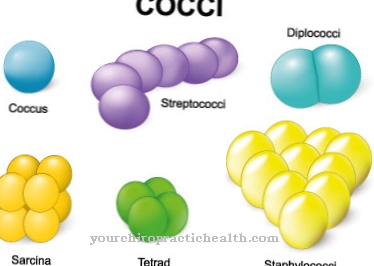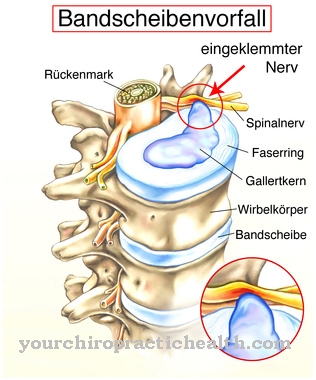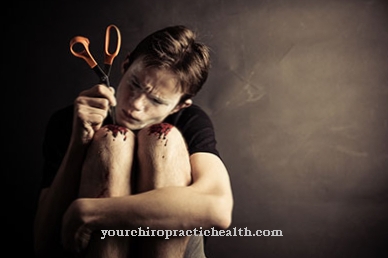Trisomy 18 or Edwards Syndrome is a disease caused by a genetic defect in chromosome 18. Instead of normally paired up, the disease has a triple chromosome. So far, no therapy is possible, the children usually only die a few days or weeks after birth.
What is trisomy 18?
The Trisomy 18 is a genetic disease. Normally every person has a chromosome set of 23 pairs, or 46 individual chromosomes. During fertilization, the pairs of mother and father divide and the respective chromosomes combine again to form new pairs.
In trisomy 18, one pair on the 18th chromosome does not divide. This creates a triple chromosome in the new connection in each cell (free trisomy 18). Since the blueprint for the human body with all its functions is located on the chromosomes, an incorrect system causes corresponding disorders and malformations.
In addition to free trisomy 18, there are other rare variants of the disease, such as mosaic trisomy 18, in which only some cells have the triple set of chromosomes, and translocation trisomy 18, in which only fragments of the 18th chromosome are triple. The disease trisomy 18 is also called Edwards syndrome, after its discoverer, the human geneticist John Hilton Edwards.
causes
The cause of the appearance of Trisomy 18 is not known. In free and mosaic trisomy 18 it happens purely by chance that one of the chromosome pairs no. 18 does not divide and is then present in triplicate in the child's cells.
The error occurs with no apparent cause during cell division. However, it is known that the older the mother, the greater the likelihood of free trisomy 18. In translocation trisomy 18, the father or mother is the carrier of the defect. This means that the disease can occur more often within the family and that the disposition for trisomy 18 can be passed on to the offspring.
Symptoms, ailments & signs
Trisomy 18 is characterized by typical symptoms that can quickly give an indication of the hereditary disease. Many physical malformations and mental impairments are particularly pronounced. The life expectancy of children with Edward's syndrome is greatly reduced.
Only around five to ten percent of those affected are older than a year. However, some children have already reached and passed the age of ten. They are born with a low birth weight because physical development in the womb is already delayed. Noticeable are deep-set ears, overgrown auricles, protruding back of the head, small chin and possibly a cleft lip and palate.
Bone malformations also occur on the ribs, vertebrae and pelvis. Many internal organs such as the heart, gastrointestinal tract or kidneys are also often deformed. The same is true of the brain. Patients also often have difficulty breathing. The bulging forehead and the short cleft eyelids are also typical. Deformed feet (club feet) are often observed.
Eye malformations and malformations of the fingers also occur. The index finger is often slapped over the third and fourth fingers. Due to the malformation of the brain, the mental and motor development of the affected children is severely retarded. The children can only sit and crawl much later. As a rule, they cannot learn to speak.
Diagnosis & course
The course of Trisomy 18 is very noticeable. Even in the womb, the children lag behind in their development. You weigh too little and your head is too small. The shape of the skull also deviates from the norm; the head is very expansive at the back.
There are also many abnormalities on the face, such as a chin that is too small, malformations of the eyes or a cleft lip and palate. The organs are not laid out normally. The heart, stomach, intestines and also the kidneys often have defects and do not function properly. The skeleton is also poorly developed; vertebrae or ribs are often missing or they are deformed.
Trisomy 18 can be diagnosed in the womb. During the regular check-ups during pregnancy, the doctor usually notices growth delays and a lack of movement. If trisomy 18 is suspected, a genetic test is usually carried out. For this purpose, amniocentesis with a cannula is taken through the abdominal wall and examined.
Since there are cells of the embryo in the amniotic fluid, a chromosome determination can be carried out with them. With this examination one can both reliably diagnose trisomy 18 and determine which form of the disease is present.
Complications
Trisomy 18 leads to various disorders and complaints. As a rule, physical and mental disabilities occur that make everyday life of the person affected considerably more difficult. The patients suffer from severe developmental disorders and also from growth disorders. In many cases, they are therefore dependent on the help of other people in their everyday lives.
The malformations of the eyes caused by trisomy 18 can have a negative effect on the eyesight of the person affected. Furthermore, a cleft palate develops, which can lead to discomfort when taking food and liquids. Many of those affected also suffer from a heart defect. If left untreated, this can lead to patient death. The clubfoot can restrict movement.
Many children also suffer from bullying and teasing as a result of trisomy 18 and as a result often develop physical complaints or depression. The parents can also be affected by the psychological complaints. Since a direct and causal treatment of trisomy 18 is not possible, there are no complications. As a rule, those affected die relatively early, so that the life expectancy of the patient is extremely limited.
When should you go to the doctor?
If you have Edwards syndrome, you must definitely see a doctor. Self-healing cannot occur, so medical treatment must be carried out in any case. The earlier the disease is recognized, the better the further course is usually. Since it is a hereditary disease, a complete cure is not possible. If you want to have children, genetic counseling should also be carried out to prevent the recurrence of Edwards syndrome.
A doctor should be contacted if the person concerned suffers from various deformities and malformations. They occur primarily on the face and can make everyday life and the life of the person affected significantly more difficult. In many cases, decreased intelligence can also indicate Edwards syndrome and should be evaluated by a doctor. Parents and relatives are also often dependent on psychological treatment so that depression or other mental disorders can be prevented.
Treatment & Therapy
There is no therapy for that Trisomy 18. The damage and malformations are so serious that no treatments are possible. With the slightly milder mosaic trisomy 18, it is sometimes possible to keep the children alive a little longer through operations and treatments. There are even a few isolated cases in which children with mosaic trisomy 18 have even reached adolescence. Free trisomy 18, on the other hand, is always fatal. The children usually only survive a few days or weeks. If the diagnosis of trisomy 18 is certain, affected parents are often advised to terminate the pregnancy during pregnancy.
prevention
Against Trisomy 18 cannot be prevented as the disease is caused by a genetic defect.
Aftercare
Follow-up care for trisomy 18 is primarily palliative in nature. The aim is to enable the children to lead a painless or painless life during their usually short life. Patients with Edwards syndrome should be examined regularly to assess their physical condition. Known physiological defects are regularly checked for changes by the attending physician.
If necessary, measures can be initiated if the condition should worsen. Since almost all children with trisomy 18 die in the first months or years of life, psychological care for their parents is also part of good aftercare. Professional family support and good palliative care for the children make it easier for everyone involved to cope with the stressful situation.
Affected families are usually not only accompanied by doctors, but also by other professional groups such as psychologists, pastors and others. Even after the death of the child, it should be continued for as long as the person concerned wishes. No special precautions have to be taken for a new pregnancy, as the risk of recurrence is low. Many parents still consult a human geneticist and can thereby reduce doubts and fears.
You can do that yourself
Since trisomy 18 is usually a very serious disease, the majority of children born die in the first few weeks of life. Even with treatment, only around 15 percent of girls live to be ten years old, and adulthood is very rarely reached. The main focus is therefore on alleviating the symptoms and accompanying the child by the family. Self-help groups and topic-related forums (e.g. Leona e.V.) enable them to exchange experiences with other affected persons.
The specific options for coping with everyday life depend on the type and severity of the disability. In severe cases, i.e. with an unfavorable prognosis, there are specialized palliative nurses for children who support the parents. While the treatment of the primary symptoms (e.g. organ damage) is left to the medical staff, the symptoms resulting therefrom (e.g. difficulty in eating) tend to be left out of the care sector. Some institutions (e.g. "Berliner Sternschnuppen") offer free care courses for parents of disabled children. Specialized outpatient care services can support and advise parents on home care.
In addition to the offers mentioned, offers for early support (physiotherapy, occupational therapy) should be used if possible. They can help relieve tension and improve motor or cognitive skills.



.jpg)
.jpg)






















